General Sir John Monash, Personal Files Book 18, 21 April - 8 May 1918, Part 9
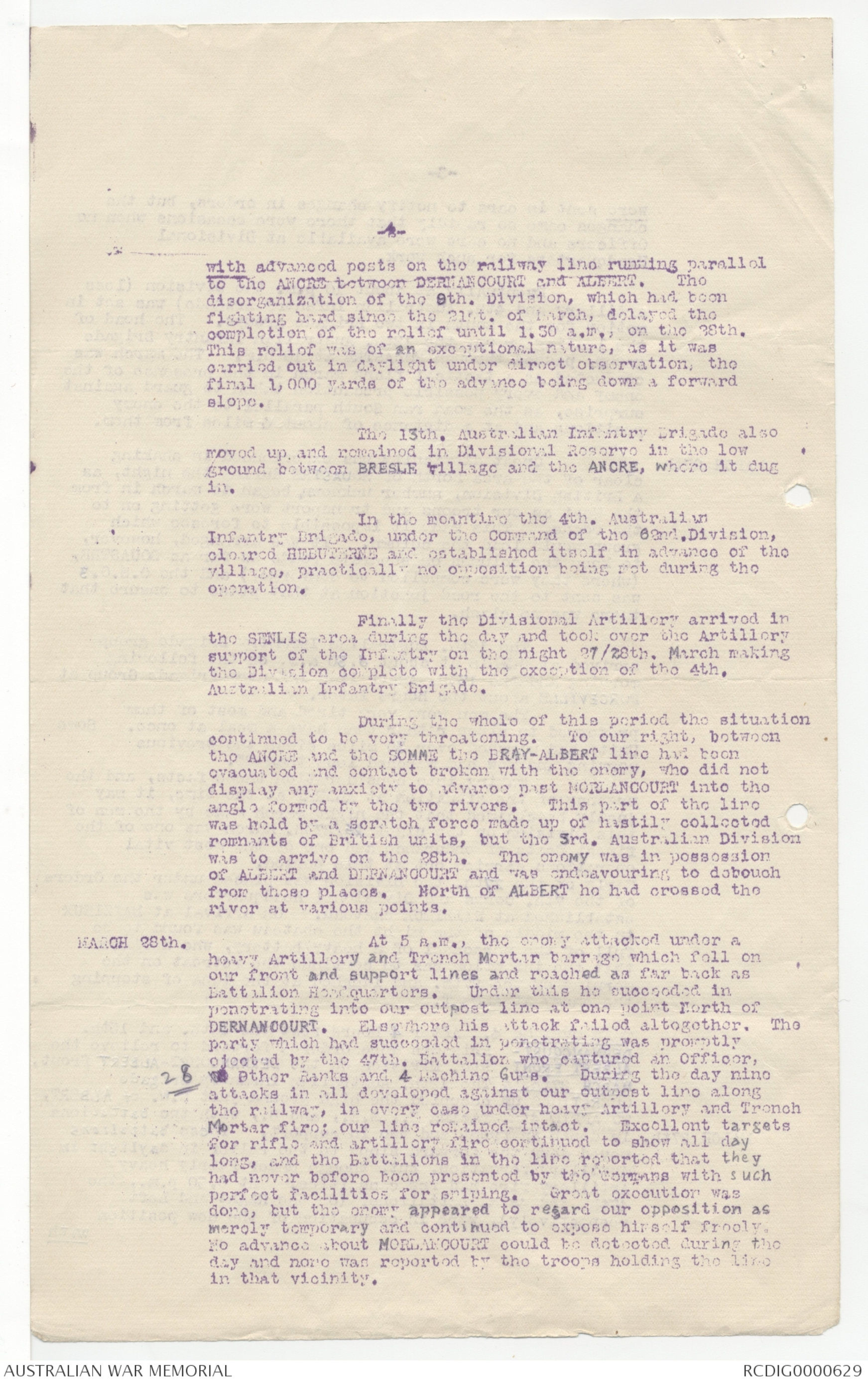
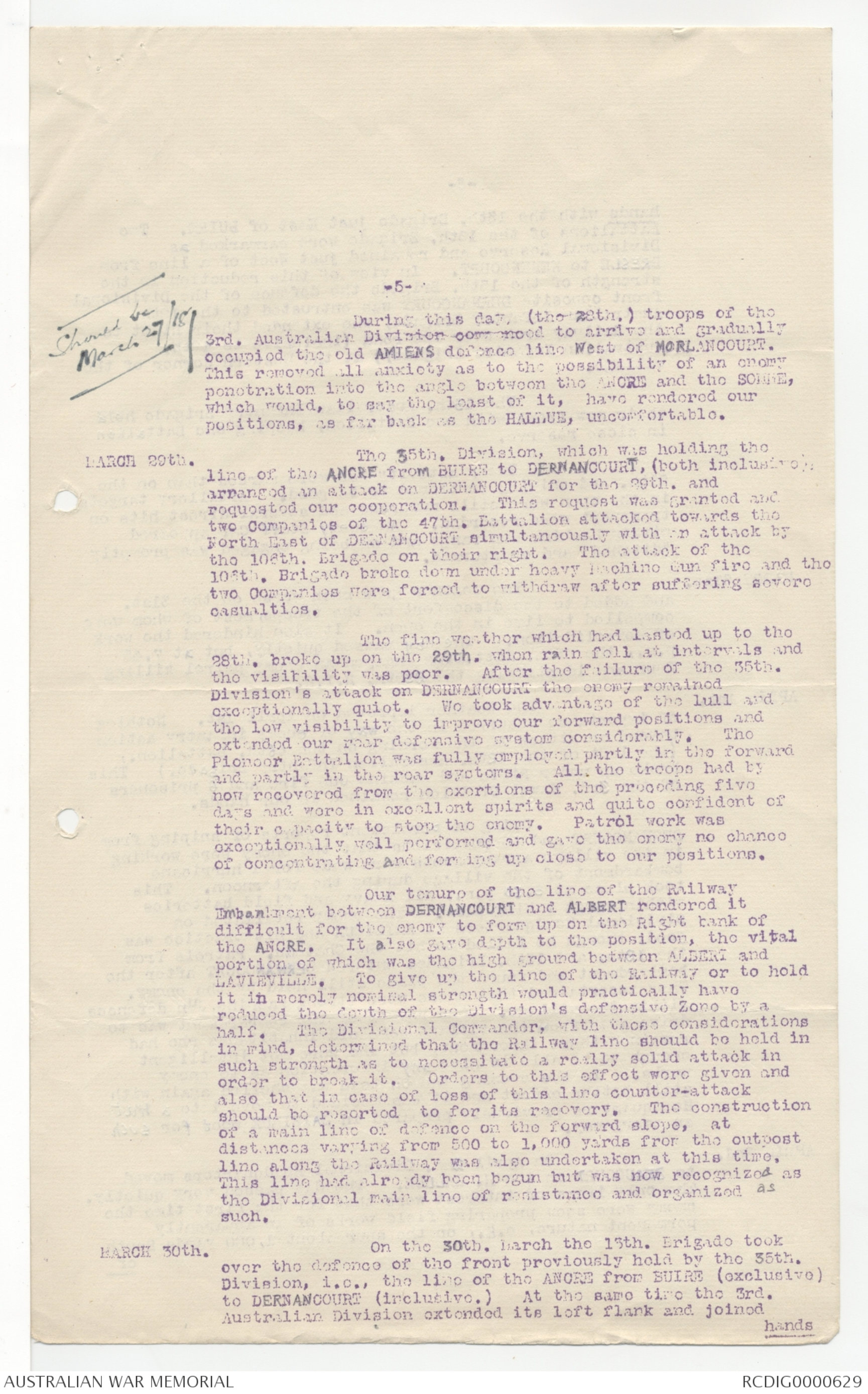
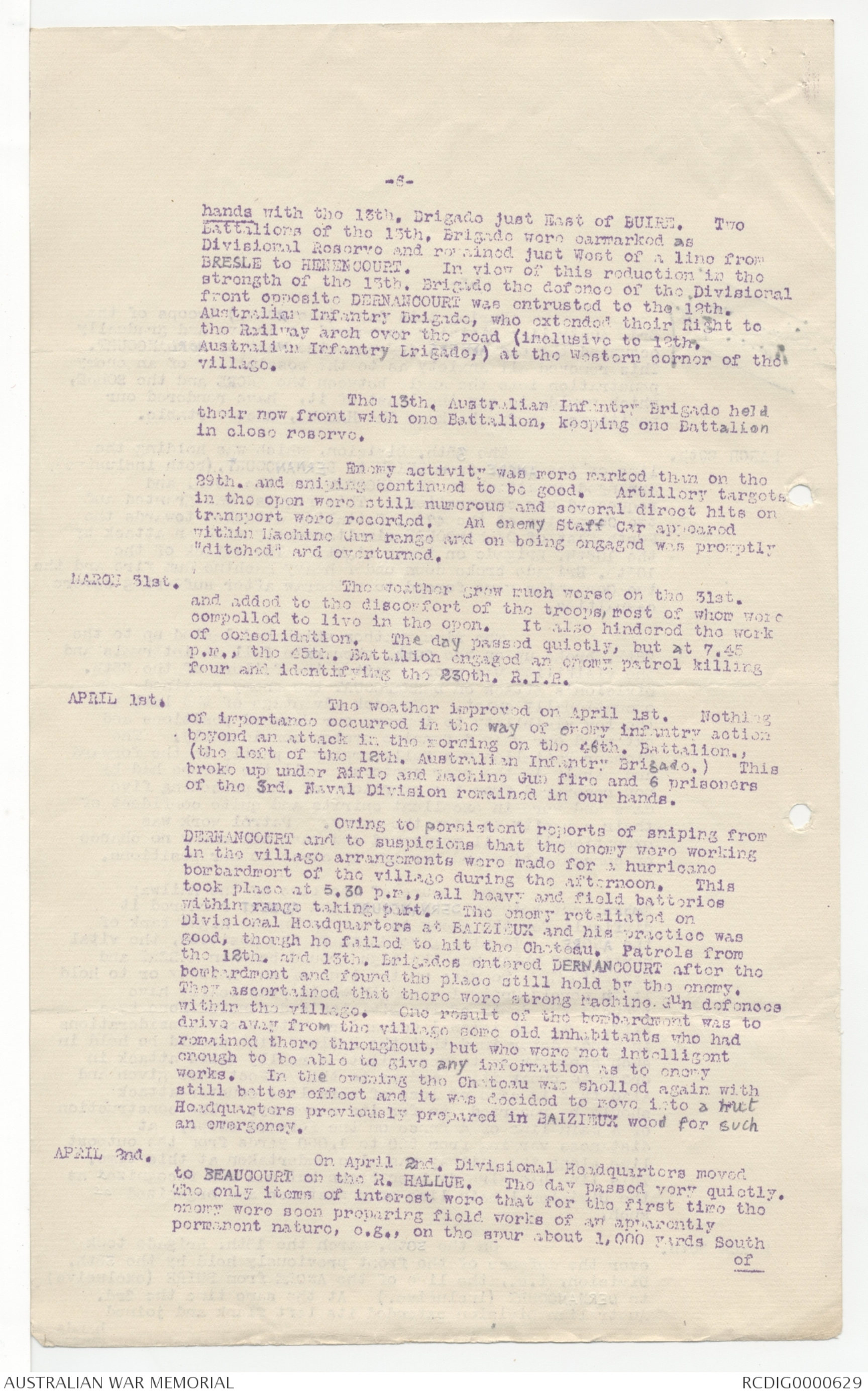
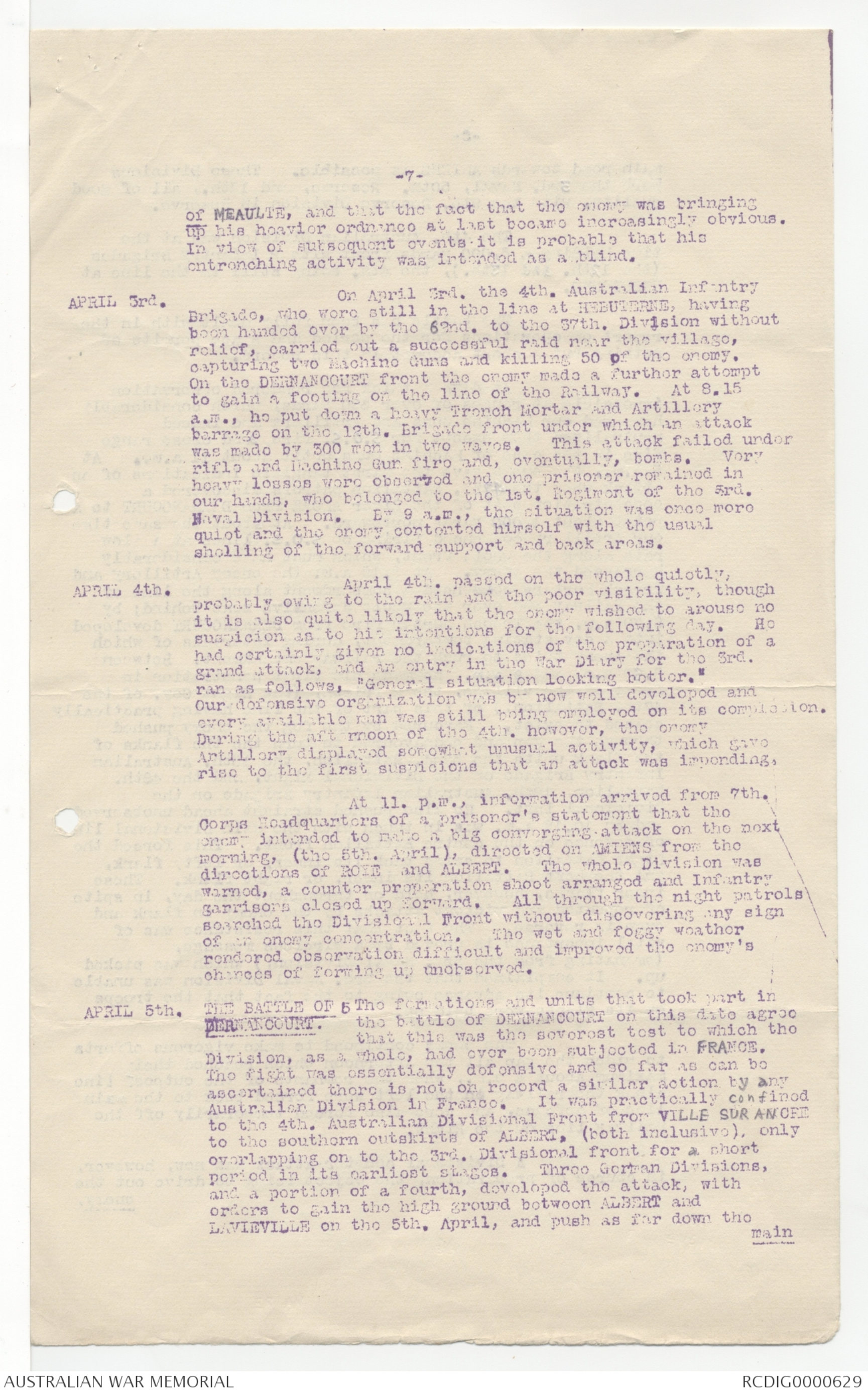
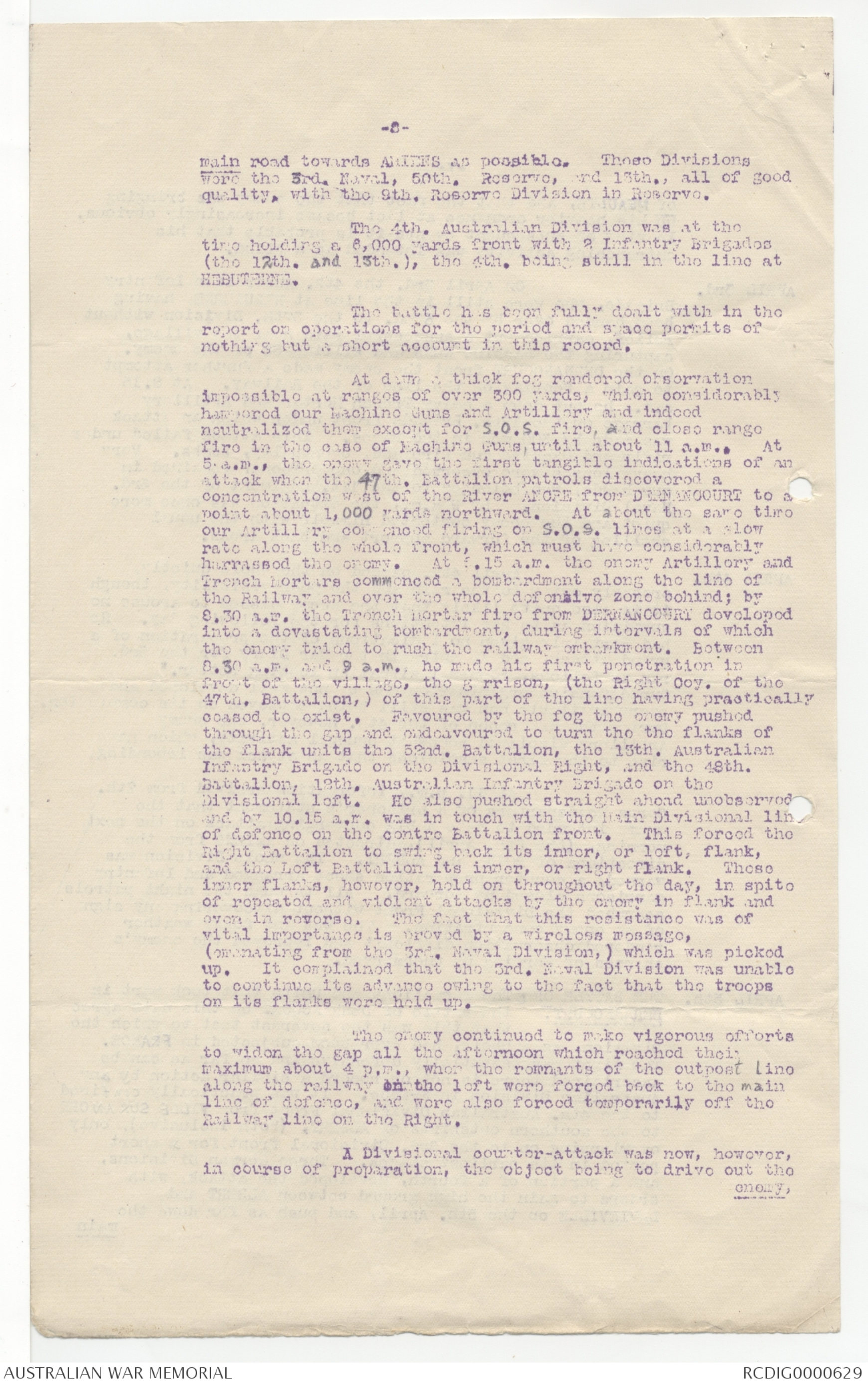
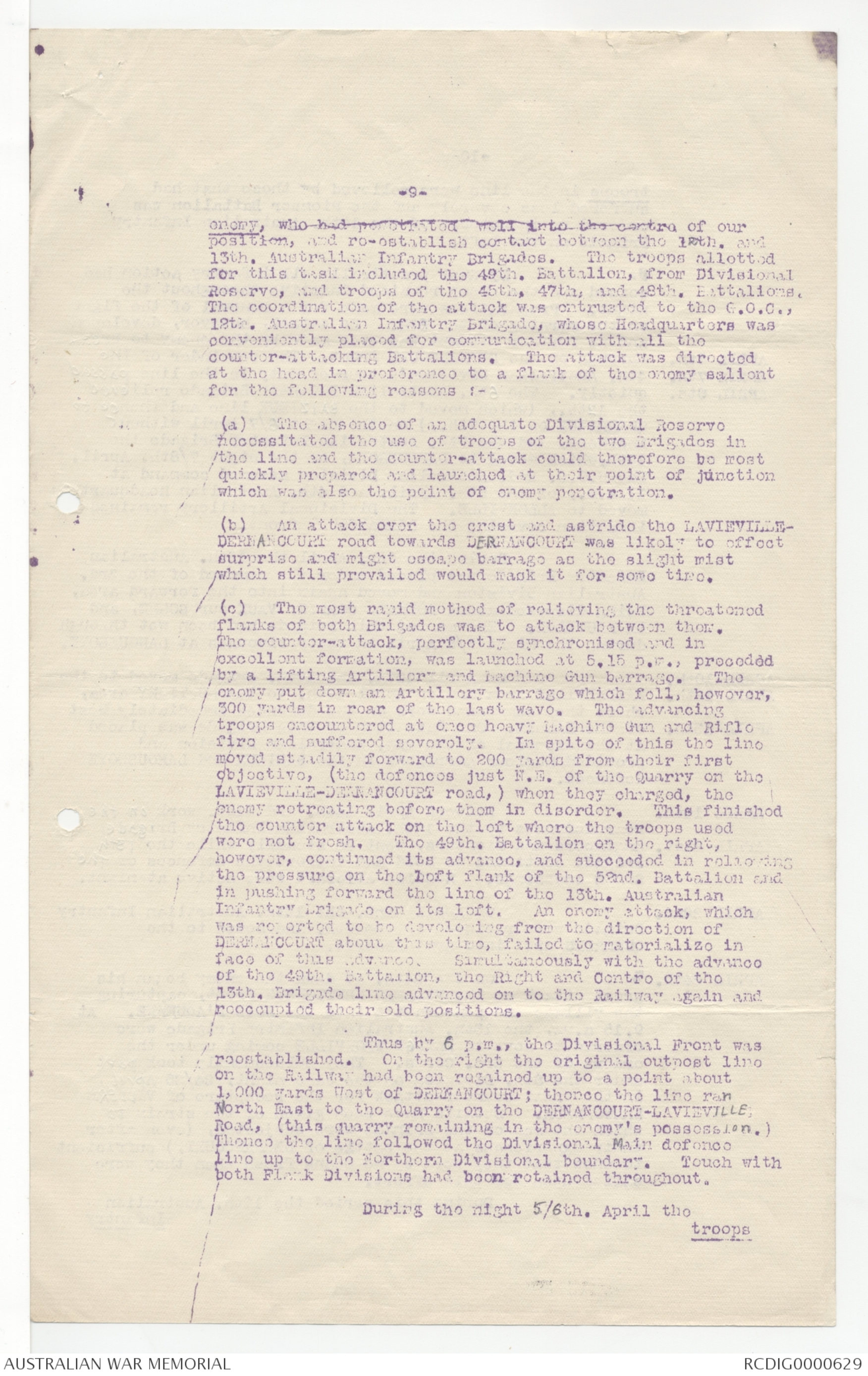
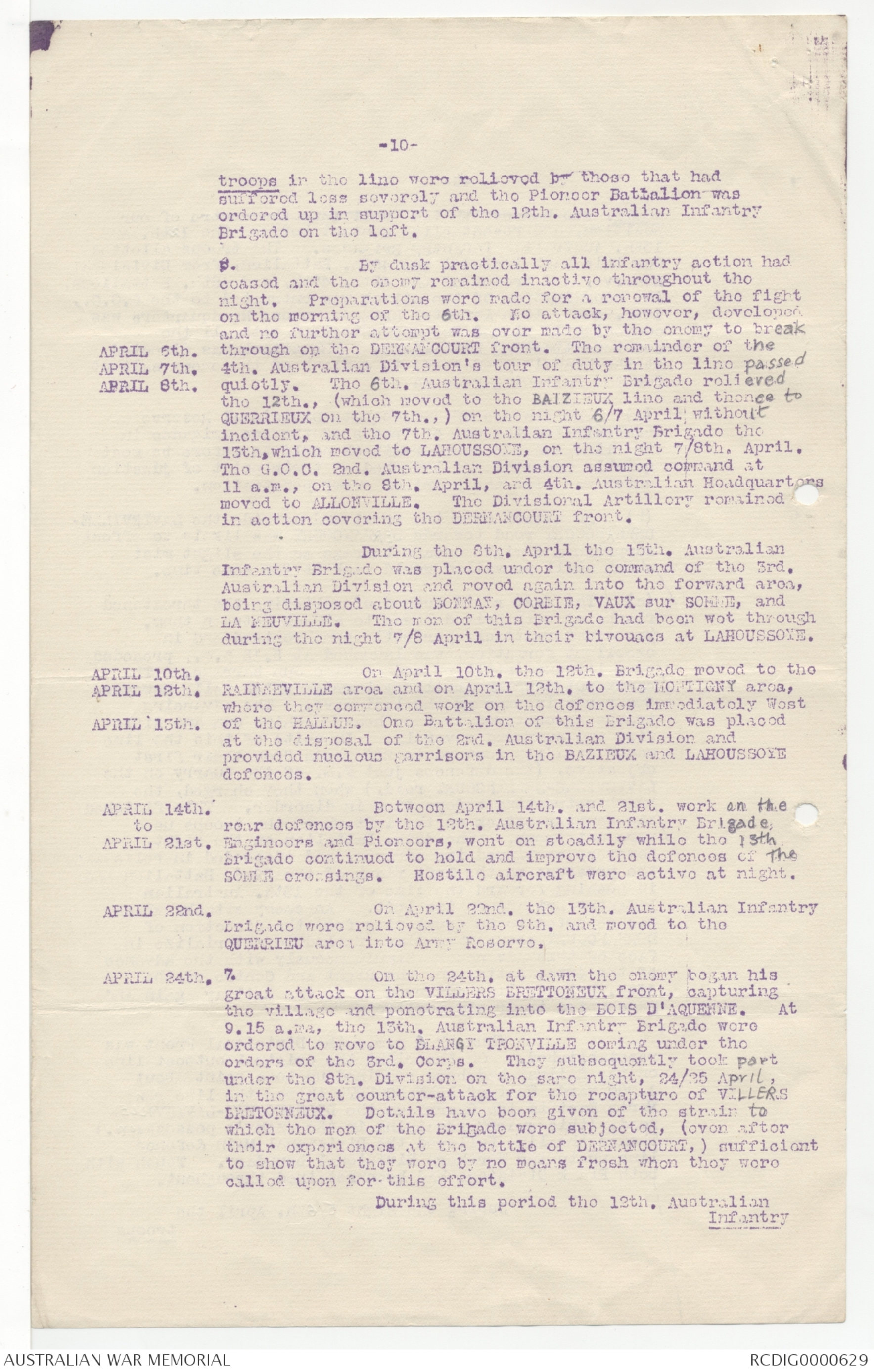
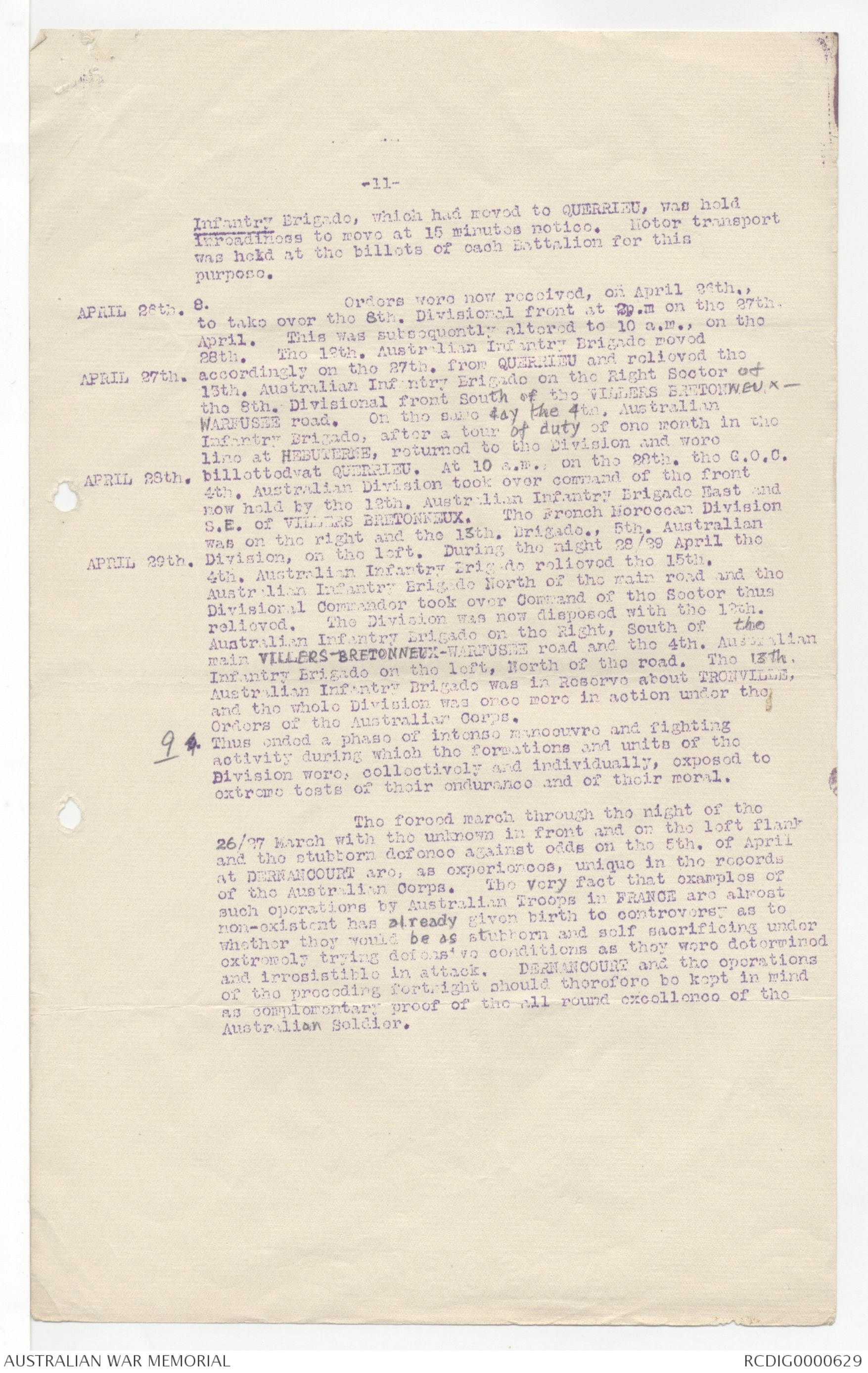

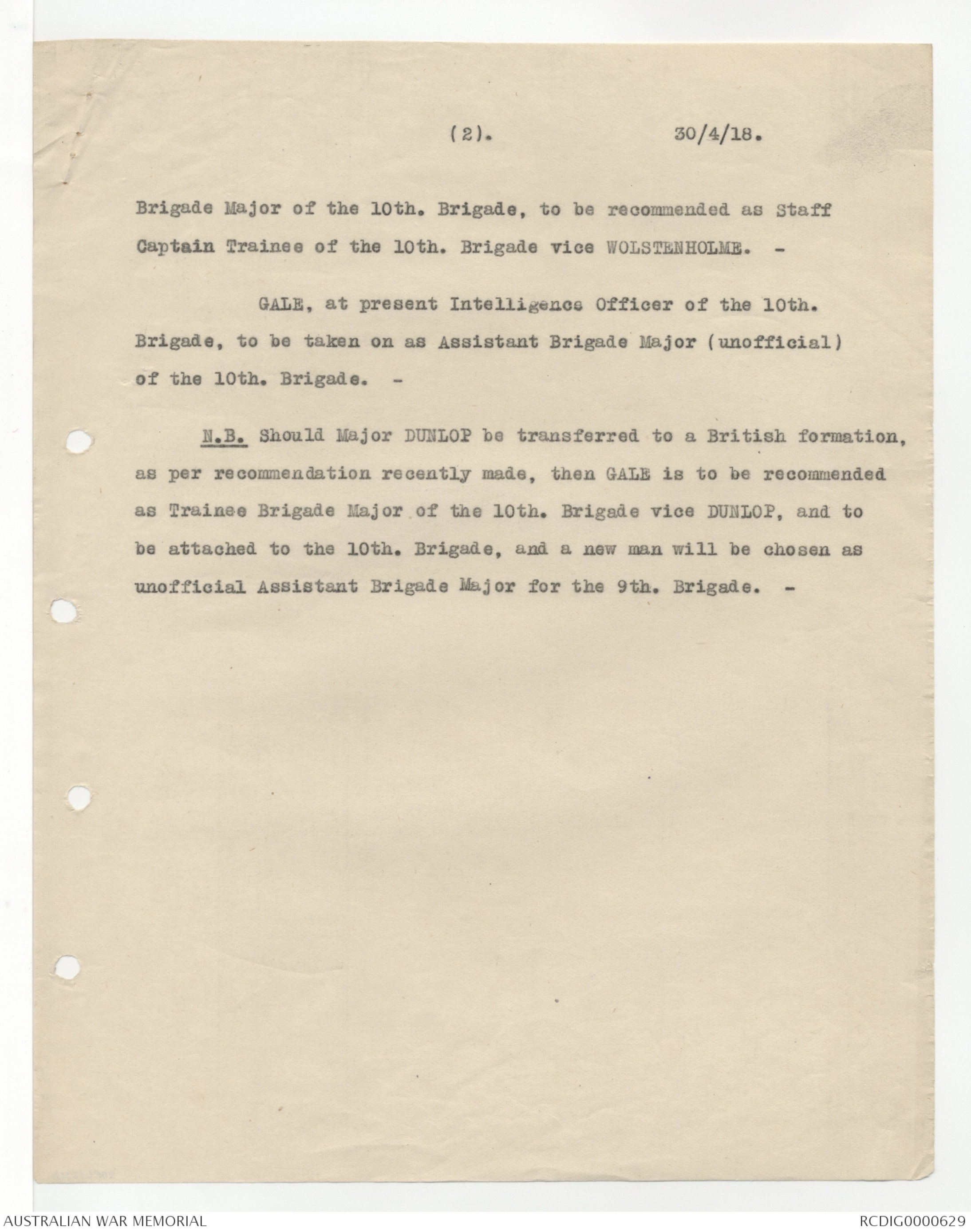
-4-
with advanced posts on the railway line running parallel
to the ANCRE between DERNANCOURT and ALBERT. The
disorganization of the 9th. Division, which had been
fighting hard since the 21st. of March, delayed the
completion of the relief until 1.30 a.m. on the 28th.
This relief was of an exceptional nature, as it was
carried out in daylight under direct observation, the
final 1,000 yards of the advance being down a forward
slope.
The 13th. Australian Infantry Brigade also
moved up and remained in Divisional Reserve in the low
ground between BRESLE village and the ANCRE, where it dug
in.
In the meantime the 4th. Australian
Infantry Brigade, under the Command of the 62nd. Division,
cleared HEBUTERNE and established itself in advance of the
village, practically no opposition being met during the
operation.
Finally the Divisional Artillery arrived in
the SENLIS area during the day and took over the Artillery
support of the Infantry on the night 27/28th. March making
the Division complete with the exception of the 4th.
Australian Infantry Brigade.
During the whole of this period the situation
continued to be very threatening. To our right, between
the ANCRE and the SOMME the BRAY-ALBERT line hvf been
evacuated and contact broken with the onery, who did not
display any anxiety to advance past MORLANCOURT into the
angle formed by the two rivers. This part of the line
was held by a scratch force made up of hastily collected
remnants of British units, but the 3rd. Australian Division
was to arrive on the 28th. The enemy was in possession
ALBERT and DERNANCOURT and was endeavouring to debouch
North of ALBERT he had crossed the
from these places. North of ALBERT he had crossed the
river at various points.
MARCH 28TH. At 5 a.m., the enemy attacked under a
heavy Artillery and Trench Mortar barrage which fell on
our front and support lines and reached as far back as
Battalion Headquarters. Under this he succeeded in
penetrating into our outpost line at one point North of
DERNANCOURT. Elsewhere his attack failed altogether. The
party which had succeeded in penetrating was promptly
ejected by the 47th. Battalion who captured an Officer,
28 18 Other Ranks and 4 Machine Guns. During the day nine
attacks in all developed against our outpost line along
the railway, in every case under heavy Artillery and Trench
Mortar fire; our line remained intact. Excellent targets
for rifle and artillery fire continued to show all day
long, and the Battalions in the line reported that they
had never before been presented by the Germans with such
perfect facilities for sniping. Grout execution was
done, but the enemy appeared to regard our opposition as
merely temporary and continued to expose himself freely.
No advance about MORLANCOURT could be detected during the
day and none was reported by the troops holding the line
in that vicinity.
-5-
[*Should be
March 27/18
During this day, (the 28th.) troops of the
3rd. Australian Division commenced to arrive and gradually
occupied the old AMIEMS defonce line West of MORLANCOURT.
This removed all anxiety as to the possibility of an enemy
penetration into the angle between the ANCRE and the SOMME,
which would, to say the least of it, have rendered our
positions, as far back as the HALLUE, uncomfortable.
MARCH 29TH. The 35th. Division, which was holding the
line of the ANCRE from BUIRE to DERNANCCURT, (both inclusion,
arranged an attack on DERNANCOURT for the 29th. and
requested our cooperation. This request was granted and
two Companies of the 47th. Battalion attacked towards the
North East of DERNANCOURT simultaneously with an attack by
the 106th. Brigade on their right. The attack of the
106th. Brigade broke down under heavy Machine Gun fire and the
two Companies wore forced to withdraw after suffering severe
casualties.
The fine weather which had lasted up to the
28th. broke up on the 29th. when rain fell at intervals and
the visibility was poor. After the failure of the 35th.
Division's attack on DERNANCOURT the enemy remained
exceptionally quiet. We took advantage of the lull and
the low visibility to improve our forward positions and
extended our rear defensive system considerably. The
Pioneer Battalion was fully employed partly in the forward
and partly in the roar systems. All the troops had by
now recovered from the exertions of the preceding five
days and were in excellent spirits and quite confident of
their capacity to stop the enemy. Patrol work was
exceptionally well performed and gave the enemy no chance
of concentrating and forming up close to our positions.
Our tenure of the line of the Railway
Embankment between DERNANCOURT and ALBERT rendered it
difficult for the enemy to form up on the Right bank of
the ANCRE. It also gave depth to the position, the vital
portion of which was the high ground between ALBERT and
LAVIEVILLE. To give up the line of the Railway or to hold
it in merely nominal strength would practically have
reduced the depth of the Division's defensive Zone by a
half. The Divisional Commander, with these considerations
in mind, determined that the Railway line should be held in
such strength as to necessitate a really solid attack in
order to break it. Orders to this effect were given and
also that in case of loss of this line counter-attack
should be resorted to for its recovery. The construction
of a main line of defence on the forward slope, at
distances varying from 500 to 1,000 yards from the outpost
line along the Railway was also undertaken at this time.
This line had already been begun but was now recognized as
the Divisional main line of resistance and organized as
such.
MARCH 30TH. On the 30th. march thE 15th. Brigade took
over the defence of the front previously held by the 35th.
Division, i.e., the line of the ANCRE from BUIRE (exclusive)
to DERNANCOURT (inclusive.) At the same time the 3rd.
Australian Division extended its left flank and joined
hands
-6-
hands with the 13th. Brigade just East of BUIRE. Two
Battalions of the 13th. Brigade were earmarked as
Divisional Reserve and remained just West of a line from
BRESLE to HENENCOURT. In view of this reductions in the
strength of the 15th. Brigade the defence of the Divisional
front opposite DERNANCOURT was entrusted to the 12th.
Australian Infantry Brigade, who extended their Right to
the Railway arch over the road (inclusive to 12th.
Australian Infantry Brigad,) at the Western corner of the
village.
The 13th, Australian Infantry Brigade held
their new front with one Battalion, keeping one Battalion
in close reserve.
Enemy activity was more marked than on the
29th. and sniping continued to be good. Artillery targets
in the open were still numerous and several direct hits on
transport wore recorded. An enemy Staff Car appeared
within Machine Gun range and on being engaged was promptly
"ditched" and overturned.
MARCH 31st. The weather grew much worse on the 31st.
and added to the discomfort of the troops, most of whom were
compelled to live in the open. It also hindered the work
of consolidation. The day passed quietly, but at 7.45
p.m. the 45th. Battalion engaged an enemy patrol killing
four and identifying the 230th. R.I.R.
APRIL 1st. The weather improved on April 1st.
Nothing of importance occurred in the way of onery infantry action
beyond an attack in the morning on the 46th. Battalion.,
(the left of the 12th. Australian Infantry Brigade.) This
broke up under Rifle and Machine Gun fire and 6 prisoners
of the 3rd. Naval Division remained in our hands.
Owing to persistent reports of sniping from
DERNANCOURT and to suspicions that the enemy were working
in the village arrangements were made for a hurricane
bombardment of the village during the afternoon, This
took place at 5.30 p.m., all heavy and field batteries
within range taking part. The enemy retaliated on
Divisional Headquarters at BAIZIEUX and his practice was
good, though he failed to hit the Chateau. Patrols from
the 12th. and 13th. Brigades entered DERNANCOURT after the
bombardment and found the place still hold by the enemy.
They ascertained that there were strong Machine Gun defences
within the village. One result of the bombardment was to
drive away from the village some old inhabitants who had
remained there throughout, but who were not intelligent
enough to be able to give any information as to enemy
works. In the evening the Chateau was shelled again with
still batter effect and it was decided to move into a hut
Headquarters previously prepared in BAIZIEUX wood for such
an emergency.
APRIL 2nd. On April 2nd. Divisional Headquarters moved
to BEAUCOURT on the R. HALLUE. The day passed very quietly.
The only items of interest were that for the first time the
enemy were seen preparing field works of an apparently
permanent nature, e.g., on the spur about 1,000 yards South
of
-7-
of MEAULTE, and that the fact that the enemy was bringing
up his heavier ordnance at last became increasingly obvious.
In view of subsequent events it is probable that his
entrenching activity was intended as a blind.
APRIL 3rd. On April 3rd. the 4th. Australian Infantry
Brigade, who were still in the line at HEBUTERNE, having
been handed over by the 62nd. to the 37th. Division without
relief, carried out a successful raid near the village,
capturing two Machine Guns and killing 50 of the enemy.
On the DERNANCOURT front the enemy made a further attempt
to gain a footing on the line of the Railway. At 8.15
a.m., he put down a heavy Trench Mortar and Artillery
barrage on the 12th. Brigade front under which an attack
was made by 300 men in two waves. This attack failed under
rifle and Machine Gun fire and, eventually, bombs. Very
heavy losses were observed and one prisoner remained in
our hands, who belonged to the 1st. Regiment of the 3rd.
Naval Division. By 9 a.m., the situation was once more
quiet and the enemy contented himself with the usual
shelling of the forward support and back areas.
APRIL 4th. April 4th. passed on the whole quietly,
probably owing to the rain and the poor visibility, though
it is also quite likely that the enemy wished to arouse no
suspicion an to his intentions for the following day. He
had certainly given no indications of the preparation of a
grand attack, and an entry in the War Diary for the 3rd.
ran as follows, "General situation looking better."
Our defensive organization was by now well developed and
every available man was still being employed on its commission.
During the afternoon of the 4th. however, the enemy
Artillery displayed somewhat unusual activity, which gave
rise to the first suspicions that an attack was impending,
At 11. p.m., information arrived from 7th.
Corps Headquarters of a prisoner's statement that the
enemy intended to make a big converging attack on the next
morning, (the 5th. April), directed on AMIENS from the
directions of ROYE, and ALBERT. The whole Division was
warned, a counter preparation shoot arranged and Infantry
garrisons closed up forward. All through the night patrols
searched the Divisional Front without discovering any sign
of any enemy concentration. The wet and foggy weather
rendered observation difficult and improved the enemy's
chances of forming up unobserved.
APRIL 5TH. THE BATTLE OF
DERNANCOURT.
The formations and units that took part in
the battle of DERNANCOURT on this date agree
that this was the severest test to which the
Division, as a whole, had ever been subjected in FRANCE.
The fight was essentially defensive and so far as can be
ascertained there is not on record a similar action by any
Australian Division in France. It was practically confined
to the 4th. Australian Divisional Front from VILLE SUR ANCRE
to the southern outskirts of ALBERT, (both inclusive), only
overlapping on to the 3rd. Divisional front for a short
period in its earliest stages. Three German Divisions,
and a portion of a fourth, developed the attack, with
orders to gain the high ground between ALBERT and
LAVIEVILLE on the 5th. April, and push as far down the
main
-8-
main road towards AMIEMS as possible. These Divisions
were the 3rd. Naval, 50th. Reserve, and 13th., all of good
quality, with the 9th. Reserve Division in Reserve.
Tho 4th. Australian Division was at the
time holding a 8,000 yards front with 2 Infantry Brigades
(the 12th. and 13th.), the 4th. being still in the line at
HEBUTERNE.
The battle has been fully dealt with in the
report on operations for the period and space permits of
nothing but a short account in this record.
At dawn a thick fog rendered observation
impossible at ranges of over 300 yards, which considerably
hampered our Machine Guns and Artillery and indeed
neutralized them except for S.O.S. fire, and close range
fire in the case of Machine Guns, until about 11 a.m.. At
5 a.m., the enemy gave the first tangible indications of an
attack when the 47th. Battalion patrols discovered a
concentration west of the River ANCRE frow DERNANCOURT to a
point about 1,000 yards northward. At about the same time
our Artillery commenced firing on S.O.S. lines at a slow
rate along the whole front, which must have considerably
harrassed the enemy. At 5.15 a.m. the enemy Artillery and
Trench mortars commenced a bombardment along the line of
the Railway and over the whole defensive zone behind; by
8.30 a.m. the Trench Mortar fire from DERNANCOURT developed
into a devastating bombardment, during intervals of which
the enemy tried to rush the railway embankment. Between
8.30 a.m. and 9 a.m., he made his first penetration in
front of the village, the garrison, (the Right Coy. of the
47th. Battalion,) of this part of the line having practically
ceased to exist. Favoured by the fog the enemy pushed
through the gap and endeavored to turn the flanks of
the flank units the 52nd. Battalion, the 15th. Australian
Infantry Brigade on the Divisional Right, and the 48th.
Battalion 12th. Australian Infantry Brigade on the
Divisional left. He also pushed straight ahead unobserved
and by 10.15 a.m. was in touch with the Main Divisional line
of defence on the center Battalion front. This forced the
Right Battalion to swing back its inner, or left, flank,
and the Left Battalion its inner, or right flank. These
inner flanks, however, held on throughout the day, in spite
of repeated and violent attacks by the enemy in flank and
even in reverse. The fact that this resistance was of
vital importance is proved by a wireless message,
(emanating from the 3rd. Naval Division,) which was picked
up. It complained that the 3rd. Naval Division was unable
to continue its advance owing to the fact that the troops
on its flanks were held up.
The enemy continued to make vigorous efforts
to widen the gap all the Afternoon which reached their
maximum about 4 p.m., when the remnants of the outpost line
along the railway on the left were forced back to the main
line of defence, and were also forced temporarily off the
Railway line on the Right.
A Divisional counter-attack was now, however,
in course of preparation, the object being to drive out the
enemy
-9-
enemy, who had penetrated well into the centre of our
position, and re-establish contact between the 12th. and
13th. Australian Infantry Brigades. The troops allotted
for this task included the 49th. Battalion, from Divisional
Reserve, und troops of the 45th, 47th, and 48th. Battalions.
The coordination of the attack was entrusted to the G.O.C.,
12th. Australian Infantry Brigade, whoso Headquarters was
conveniently placed for communication with all the
counter-attacking Battalions. The attack was directed
at the head in preference to a flank of the enemy salient
for the following reasons:-
(a) The absence of an adequate Divisional Reserve
necessitated the use of troops of the two Brigades in
the line and the counter-attack could therefore be most
quickly prepared and launched at their point of junction
which was also the point of enemy penetration.
(b) An attack over the crest und astride the LAVIEVILLE-DERNANCOURT
road towards DERNANCOURT was likely to effect
surprise and might escape barrage as the slight mist
which still prevailed would mask it for some time.
(c) The most rapid method of relieving the threatened
flanks of both Brigades was to attack between them.
The counter-attack, perfectly synchronised and in
excellent formation, was launched at 5.15 p.m., preceded
by a lifting Artillery and Machine Gun barrage. The
enemy put down an Artillery barrage which fell, however,
300 yards in rear of the last wave. The advancing
troops encountered at once heavy Machine Gun and Rifle
fire and suffered severely. In spite of this the line
moved steadily forward to 200 yards from their first
objective, (the defences just N.E. of the Quarry on the
LAVIEVILLE-DERNANCOURT road,) when they charged, the
enemy retreating before them in disorder. This finished
(the counter attack on the left where the troops used
were not fresh. The 49th. Battalion on the right,
however, continued its advance, and succeeded in relieving
the pressure on the left flank of the 52nd. Battalion and
in pushing forward the line of the 13th. Australian
Infantry Brigade on its left. An enemy attack, which
was reported to be developing from the direction of
DERNANCOURT about this time, failed to materialize in
face of this advance. Simultaneously with the advance
of the 49th. Battalion, the Right and Centre, of the
13th. Brigade line advanced on to the Railway again and
reoccupied their old positions.
Thus by 6 p.m., the Divisional Front was
reestablished. On the right the original outpost line
on the Railway had been regained up to a point about
1,000 yards West of DERNANCOURT; thence the line ran
North East to the Quarry on the DERNANCOURT-LAVIEVILLE
Road, (this quarry remaining in the enemy's possession.)
Thence the line followed the Divisional Main defence
line up to the Northern Divisional boundary. Touch with
both Flank Divisions had been retained throughout.
During the night 5/6th. April the
troops
-10-
troops in the line were relieved by those that had
suffered loss severely and the Pioneer Battalion was
ordered up in support of the 12th. Australian Infantry
Brigade on the left.
d. By dusk practically all infantry action had
ceased and the enemy remained inactive throughout the
night. Preparations were made for a renewal of the fight
on the morning of the 6th. No attack, however, developed
and no further attempt was over made by the enemy to break
APRIL 6th. through on the DERNANCOURT front. The remainder of the
APRIL 7th. 4th. Australian Division's tour of duty in the line passed
APRIL 8th. quietly. The 6th. Australian Infantry Brigade relieved
the 12th., (which moved to the BAIZIEUX line and thence to
QUERRIEUX on the 7th.,) on the night 6/7 April without
incident, and the 7th. Australian Infantry Brigade the
13th, which moved to LAHOUSSOYE, on the night 7/8th. April.
The G.O.C. 2nd. Australian Division assumed command at
11 a.m., on the 8th. April, and 4th. Australian Headquarters
moved to ALLONVILLE. The Divisional Artillery remained
in action covering the DERNANCOURT front.
During the 8th. April the 15th. Australian
Infantry Brigade was placed under the command of the 3rd.
Australian Division and moved again into the forward area,
being disposed about BONNAY, CORBIE, VAUX sur SOMME, and
LA NEUVILLE. The men of this Brigade had been wet through
during the night 7/8 April in their bivouacs at LAHOUSSOYE.
APRIL 10th. On April 10th. the 12th. Brigide moved to the
APRIL 12th. RAINNEVILLE area and on April 12th. to the MONTIGNY area,
where they commenced work on the defences immediately West
APRIL 13th. of the HALLUE. One Battalion of this Brigide was placed
at the disposal of the 2nd, Australian Division and
provided nucleus garrisons in the BAZIEUX and LAHOUSSOYE
defences.
APRIL 14th
to
APRIL 21st. Between April 14th. and 21st, work on the
rear defences by the 12th. Australian Infantry Brigade,
Engineers and Pioneers, went on steadily while the 13th
Brigade continued to hold and improve the defences of the
SOMME crossings. Hostile aircraft were active at night.
APRIL 22nd. On April 22nd. the 13th. Australian Infantry
Brigade were relieved by the 9th. and moved to the
QUERRIEU area into Army Reserve.
APRIL 24th. 7. On the 24th. at dawn the enemy began his
great attack on the VILLERS BRETTONEUX front, capturing
the village and penetrating into the BOIS D'AQUENNE. At
9.15 a.m, the 13th. Australian Infantry Brigade were
ordered to move to BLANGY TRONVILLE coming under the
orders of the 3rd. Corps. They subsequently took part
under the 8th. Division on the same night, 24/25 April,
in the great counter-attack for the recapture of VILLERS
BRETONNEUX. Details have been given of the strain to
which the men of the Brigade were subjected, (even after
their experiences at the battle of DERNANCOURT,) sufficient
to show that they were by no means fresh when they were
called upon for this effort.
During this period the 12th. Australian
Infantry
-11-
Infantry Brigade, which had moved to QUERRIEU, was held
inreadiness to move at 15 minutes notice. Motor transport
was held at the billets of each Battalion for this
purpose.
APRIL 26th. 8. Orders were now received, on April 26th.,
to take over the 8th. Divisional front at 2p.m on the 27th.
April. This was subsequently altered to 10 a.m., on the
28th. The 12th. Australian Infantry Brigade moved
APRIL 27th. accordingly on the 27th. from QUERRIEU and relieved the
15th. Australian Infantry Brigide on the Right Sector of
the 8th. Divisional front South of the VILLERS BRETONNEUX-WARFUSEE road. On the same day the 4th. Australian
Infantry Brigade, after a tour of duty of one month in the
line at HEBUTERNE, returned to the Division and were
APRIL 28th billeted at QUERRIE. At 10 a.m., on the 28th. the G.O.C.
4th. Australian Division took over command of the front
now held by the 12th. Australian Infantry Brigade East and
S.E. of VILLERS BRETONNEUX. The French Moroccan Division
was on the right and the 13th. Brigade., 5th. Australian
APRIL 29th. Division on the left. During the night 28/29 April the
4th. Australian Infantry Brigade relieved the 15th.
Australian Infantry Brigade North of the main road and the
Divisional Commander took over Command of the Sector thus
relieved. The Division was now disposed with the 12th.
Australian Infantry Brigade on the Right, South of the
main VILLERS-BRETONNEUX-WARFUSEE road and the 4th. Australian
Infantry Brigade on the left, North of the road. The 13th
Australian Infantry Brigade was in Reserve about TRONVILLE,
and the whole Division was once more in action under the
Orders of the Australian Corps.
9 4. Thus ended a phase of intense manoeuvre and fighting
activity during which the formations and units of the
Division were, collectively and individually, exposed to
extreme tests of their endurance and of their moral.
Tho forced march through the night of the
26/27 March with the unknown in front and on the left flank
and the stubborn defence against odds on the 5th. of April
at DENANCOURT are, as experiences, unique in the records
of the Australian Corps. The very fact that examples of
such operations by Australian Troops in FRANCE are almost
non-existent has already given birth to controversy as to
whether they would be as stubborn and self sacrificing under
extremely trying defensive conditions as they were determined
and irresistible in attack. DERNANCOURT and the operations
of the preceding fortnight should therefore be kept in mind
as complementary proof of the all round excellence of the
Australian Soldier.
THIRD AUSTRALLAN DIVISION.
Divisional Headquarters
30th. April, 1918.
Memo for "A.Q."
Prepare recommendations to D.A.G. - A.I.F. and take other
administrative action to bring about the following changes in the
Divisional Staff Trainees.-
Captain CRUICKSHANK to cease to be Trainee Brigade Major,
11th. Brigade, and to revert to regimental duty and to cease to be
seconded. -
Captain WOLSTENHOLME, on termination of six months tour
of duty, to revert to regimental duty and cease to be seconded as
Trainee Staff Captain, 10th. Brigade. - In making this recommendation,
state that it is considered Captain WOLSTENHOLME is fit for
immediate appointment as a Staff Captain in any vacancy that
might arise in the A. I. F. -
Captain HAWKINS of 9th. Brigade to be appointed Trainee
Brigade Major vice CRUICKSHANK, and to be attached to the 11th.
Brigade.
MARTIN, at present unofficially posted as Assistant
(1).
(2).
30/4/18.
Brigade Major of the 10th. Brigade, to be recommended as Staff
Captain Trainee of the 10th. Brigade vice WOLSTENHOLME. -
GALE, at present Intelligence Officer of the 10th.
Brigade, to be taken on as Assistant Brigade Major (unofficial)
of the 10th. Brigade.
N.B. Should Major DUNLOP be transferred to a British formation,
as per recommendation recently made, then GALE is to be recommended
as Trainee Brigade Major of the 10th. Brigade vice DUNLOP, and to
be attached to the 10th. Brigade, and a new man will be chosen as
unofficial Assistant Brigade Major for the 9th. Brigade. -
 Sam scott
Sam scottThis transcription item is now locked to you for editing. To release the lock either Save your changes or Cancel.
This lock will be automatically released after 60 minutes of inactivity.